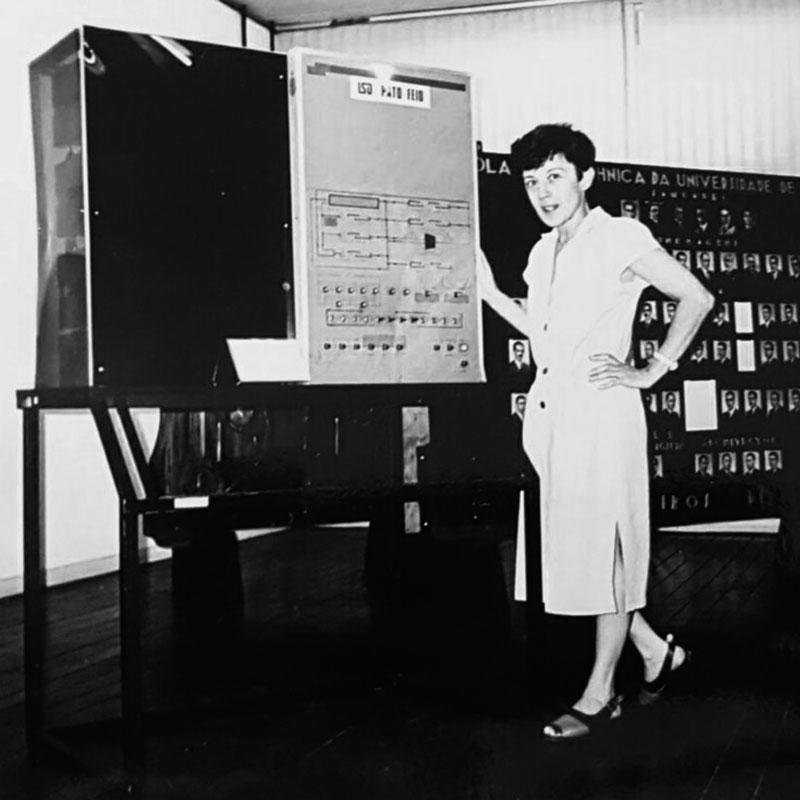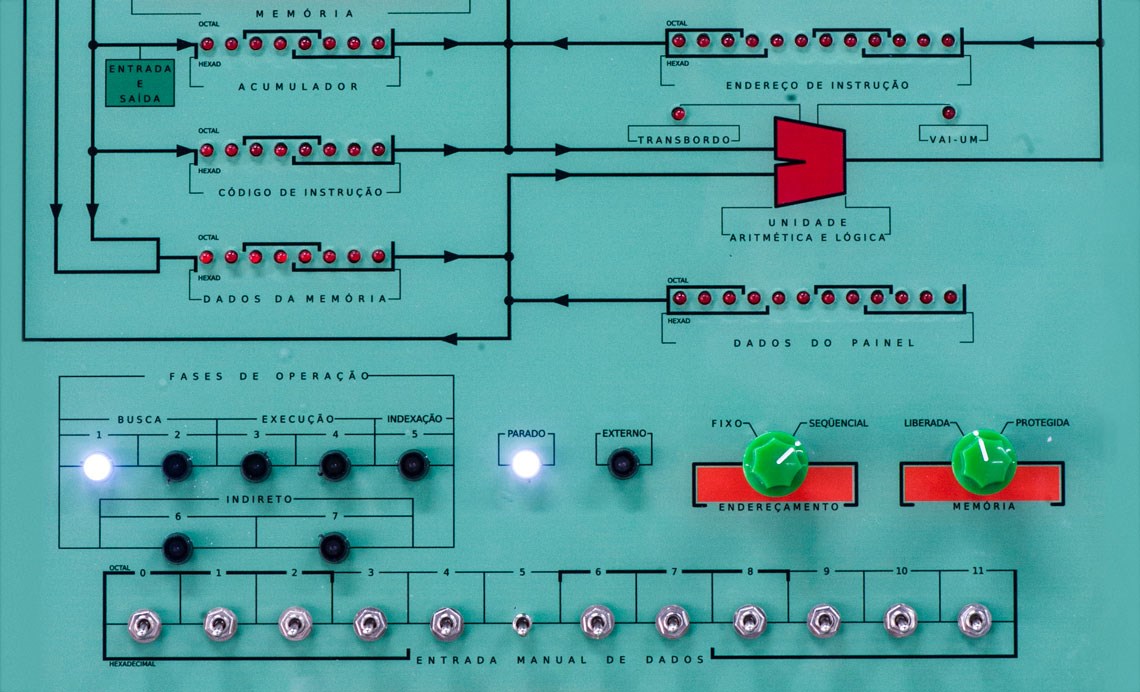The first Brazilian computer was called Patinho Feio, or Ugly Duckling in English, and was created in 1972 as a final project of Computer Architecture, a subject from the graduate course in electrical engineering of the then Department of Electrical Engineering of the Polytechnic School at the University of São Paulo (POLI-USP). The machine provided an extensive legacy for teaching and the computer industry in the country. It served as a basis for the development of another computer, the G-10, commissioned by the Brazilian Navy and built in a partnership between POLI-USP and the Pontifical Catholic University of Rio de Janeiro (PUC-RJ). The G-10 was the prototype for the country’s first commercial computer, the MC 500, released by Cobra Computadores e Sistemas Brasileiros—a state company created in 1974 with the aim of developing national computer technology.
To enable the Polytechnic School to receive funding for the construction of the G-10, the Foundation for the Technological Development of Engineering (FDTE) was established, one of the country’s pioneering entities with the mission of integrating public universities and private initiatives in technological innovation and development efforts. “The Ugly Duckling, built with funding from the Polytechnic budget, is not just a part of history. It is a project that brought developments which to this day reverberate in the country’s technological development,” says electrical engineer José Roberto Castilho Piqueira, former director of POLI-USP and current director of operations of the FDTE. On September 22 of this year, the academic unit of USP held a commemorative event to mark 50 years of the Ugly Duckling and the FDTE.
A metallic box weighing 100 kilos with 1 meter (m) in height, 1 m in length, and 80 centimeters wide (see Pesquisa FAPESP issue no. 76), the Ugly Duckling had 450 integrated circuits, with around 3,000 logic blocks, spread across 45 printed circuit boards. It was designed with just 4 kilobytes (kB) of memory, an insignificant value today when the memories of pocket-sized smartphones are counted in tens of gigabytes (GB). Even at that time, the USP machine’s 4 kB were not significant. Some computer models had much larger storage capacity, including the IBM System 360, a family of mainframes—computer systems used for processing large volumes of data—used in the Apollo mission that took man to the Moon in 1969. At the start of the 1970s, there were already versions of it with hundreds of kB of memory.
To understand the importance of the Ugly Duckling for Brazil, it is necessary to put its development into context. Before it, a single experience in the field of computing had been promoted with Brazilian efforts. In 1961, electronic engineering students from the Aeronautics Institute of Technology (ITA), in São José dos Campos, São Paulo State, built Zezinho, a very simple computer exclusively for teaching purposes, which in practice did not execute computing tasks (see Pesquisa FAPESP issue no. 101).

Personal Archive Edith Ranzini, one of the postgraduate students at USP who took part in the venture, in front of the pioneering computerPersonal Archive
Seven years later, in 1968, when graduate or postgraduate computing courses were still inexistent in Brazil, the Department of Electrical Engineering of POLI-USP created the Digital Systems Laboratory (LSD)—today the Department of Computing and Digital Systems Engineering (PCS)—to house an IBM 1620 that was to be decommissioned. The device had been donated by the USP Electronic Computing Center. The objective of the group was for the equipment to be studied in reverse engineering procedures, in other words, disassembled to understand how it worked, and then reassembled.
Professionals trained on the engineering courses at that time had almost no prospect of employment in the field. “Our job market was restricted to business representative positions for the electronic equipment companies that sold the few computers available in the country. A small portion managed to be placed as systems analysts,” recalls electrical engineer Edith Ranzini, who graduated in 1969 and was one of the first members of the LSD.
In 1970, Antônio Hélio Guerra Vieira, a professor at POLI who later became president of FAPESP (1979–1985) and dean of USP (1982–1986), devised a reform known as “Curriculum 70,” which separated graduation in electrical engineering at the Polytechnic School in two fronts: one with an emphasis on telecommunications and the other on digital systems. It turned out that there were no professors qualified for the Digital Systems course. It was necessary to train them, so several subjects in the area of computing and electronics were introduced into the postgraduation electrical engineering program, which relied on foreign professors. One of them was North American Glen Langdon Jr. (1936–2014), who had already worked at IBM Brazil. It was he who proposed, in 1971, to the pioneering class of 18 students on the Computer Architecture course, to build a computer as a final project of the postgraduate course.
It was a huge challenge. The students from USP had to design and build the hardware, software, and interfaces with the peripherals, that is, devices that aid in the use of the machine. “None of this was produced in Brazil at the time. We had to learn to make each item,” recalls Ranzini.
The name Ugly Duckling came from a joke by Paulo Wanderlei Patullo, a master’s student at the time. The University of Campinas (UNICAMP) had announced an agreement with the Brazilian Navy to build what would be the first Brazilian computer, the White Swan. “We said that we were building the Ugly Duckling, but that it would be the first to work. In the end, it was the only one of the two that materialized,” said Patullo at the 50-year ceremony.
The inauguration of the Ugly Duckling took place on July 24, 1972, and was attended by then Governor of São Paulo, Laudo Natel, the dean of USP at the time, Miguel Reale, and Bishop Dom Ernesto de Paula, who blessed the machine. Interestingly, there was no demonstration of the working computer. An anxious photographer stepped on the wire and turned off the equipment, which took too long to be restarted.

Miguel Boyayan / Pesquisa FAPESP MagazineInternal view of the equipment: 450 integrated circuits distributed on 45 printed circuit boardsMiguel Boyayan / Pesquisa FAPESP Magazine
As his colleagues at POLI describe, Guerra Vieira, currently 92 years old, whenever asked, says that the main legacy of the Ugly Duckling was training a team of qualified professors who spread the teaching of computing in the country. “It was a learning process that we took into the classrooms. We taught what we experienced, not just what we had read,” says Ranzini. “It was a huge privilege to be taught by professors who had taken part in this project. We felt like they really knew the challenges of computing,” says Jaime Simão Sichman, trained at POLI in the 1980s and current head of the school’s PCS.
The legacy for the industry was equally important. Edson Fregni, Celso Ikeda, and Josef Manasterski, who were all part of the class of students at POLI, founded Scopus Tecnologia in 1975, the first Brazilian company for peripheries, which released the line of Nexus microcomputers in the 1980s. Itautec, a banking automation equipment manufacturer, also had graduates from the class among its staff and maintained, for years, technology development projects with support of the POLI LSD.
The FDTE institution is only not older than the Vanzolini Foundation, linked to the Department of Production Engineering at POLI. “The foundations of POLI are institutions that enable the engineering professors and students to keep in close contact with the needs of the industry, with great benefit to both sides,” summarizes Piqueira.
Among the main works developed throughout the history of the FDTE are the São Paulo Metro security analysis projects, the system for operating and controlling the trains of Ferrovia Paulista (FEPASA)—current Companhia Paulista de Trens Metropolitanos, CPTM—and a series of banking and industrial automation projects. The FDTE has an agreement with the International Energy Agency (AIEA) for risk simulations in nuclear power plant activities and provided support to the implementation of security systems in electrical and telephone networks.
“The Ugly Duckling was an exemplary public investment,” states Piqueira. “It cost the equivalent of buying a new basic car in 1972 and generated lots of direct and indirect benefits.”
Republish

